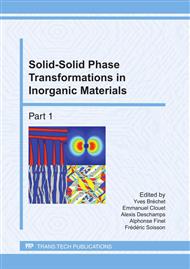[1]
J.E. Ayers: Heteroepitaxy of Semiconductors: Theory, Growth, and Characterization (Taylor & Francis Group, New York 2007).
Google Scholar
[2]
M. Volmer and A. Weber: Z. Phys. Chem. Vol. 119 (1926), p.277.
Google Scholar
[3]
I.N. Stranski and Von L. Krastanow: Akad. Wiss. Lit. Mainz Math. -Natur. Kl. IIb Vol. 146 (1939), p.797.
Google Scholar
[4]
J. H. Claassen, S. A. Wolf, S.B. Qadri, et al: J. Cryst. Growth Vol. 81 (1987), p.557.
Google Scholar
[5]
M. Shigeta, Y. Fujii, A. Ogura, et al: J. Cryst. Growth Vol. 93 (1988), p.766.
Google Scholar
[6]
J. Plitzko, M. Rösler and K.G. Nickel: Diam. Relat. Mater. Vol. 6 (1997), p.935.
Google Scholar
[7]
F. Riesz, J. Varrio, A. Pesek, et al: Appl. Surf. Sci. Vol. 75 (1994), p.248.
Google Scholar
[8]
M. Peruzzil, J.D. Pedarnig, D. Bäuerle et al: Appl. Phys. A Vol. 79 (2004), p.1873.
Google Scholar
[9]
Z-A. He, D.J. Smith and P.A. Bennett: Appl. phys. Lett. Vol. 86 (2005), 143110.
Google Scholar
[10]
A. Riemann, S. Fölsch and K.H. Rieder: Phys. Rev. B Vol. 72 (2005), 125423.
Google Scholar
[11]
W-Z. Zhang, in: Proc of 4th Inter. Conf. on Solid-Solid Phase Transformations, edited by M. Koiwa, K. Otsuka and T. Miyazaki. Japan Inst. of Metals (1999), p.581.
Google Scholar
[12]
W-Z Zhang and G.C. Weatherly: Prog. Mater. Sci. Vol. 50 (2005), p.181.
Google Scholar
[13]
P.M. Kelly and M-X Zhang: Mater. Forum Vol. 23 (1999), p.41.
Google Scholar
[14]
P.M. Kelly and M-X Zhang: Metall. Mater. Trans. A Vol. 37A (2006), p.833.
Google Scholar
[15]
K. N. Tu, R.D. Thompson and B.Y. Tsaur: Appl. Phys. Lett. Vol. 38 (1981), p.626.
Google Scholar
[16]
Z. He, D.J. Smith and P.A. Bennett: Appl. Phys. Lett. Vol 86 (2005), 143110.
Google Scholar
[17]
Z. He, D.J. Smith and P. A. Bennett: Phys. Rev. B Vol. 70 (2004), 241402.
Google Scholar
[18]
G. Ye, J. Nogami and M.A. Crimp: Thin Solid Films Vol. 497 (2006), 48.
Google Scholar
[19]
J. Nogami, B.Z. Liu, M.V. Katkov, et al: Phys. Rev. B Vol. 63 (2001), 233305.
Google Scholar
[20]
C. Preinesberger, S.K. Becker, S. Vandre, et al: J. Appl. Phys. Vol 91 (2002), 1695.
Google Scholar
[21]
Z. He, D.J. Smith and P.A. Bennett: Appl. Phys. Lett. Vol 83 (2003), 5292.
Google Scholar
[22]
M-X. Zhang and P. M. Kelly: Scripta. Mater. Vol 52 (2005), 963.
Google Scholar
[23]
W-Z. Zhang, F. Ye, C. Zhang, Y. Qi and H-S. Fang: Acta Mater. Vol. 48 (2000), p.2209.
Google Scholar
[24]
J. Wu, W-Z. Zhang, X-F. Gu: Acta Mater. Vol. 57 (2009), p.635.
Google Scholar
[25]
F. Ye and W-Z. Zhang: Acta Mater. Vol. 50 (2002), p.2761.
Google Scholar
[26]
D. Qiu, P.M. Kelly and M-X. Zhang: Scripta Mater. Vol. 60 (2009), p.787.
Google Scholar
[27]
Z. He, D.J. Smith and P.A. Bennett: Phy. Rev. Lett. Vol. 93 (2004), 256102.
Google Scholar


